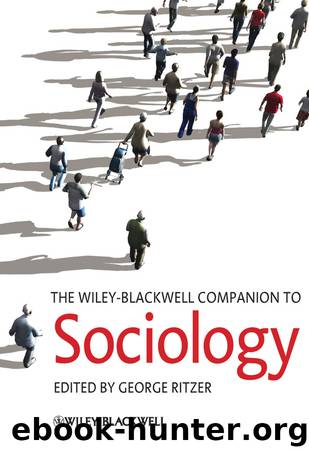The Wiley-Blackwell Companion to Sociology by Ritzer George

Author:Ritzer, George
Language: eng
Format: epub
Publisher: John Wiley & Sons
Published: 2012-10-13T16:00:00+00:00
18
Changing Families
Fluidity, Partnership, and Family Structure
Graham Allan and Emma Head
Over the last 30 years, patterns of family living have altered quite dramatically across a wide range of industrialized societies. Changes have affected many areas of family life including household composition, age and rates of marriage, patterns of childbearing, trends in cohabitation, the numbers of gay and lesbian partnerships, levels of separation, divorce, and remarriage/re-partnering, and the numbers of lone-parent households and stepfamilies (Teachman, Tedrow & Crowder 2000; Cherlin 2004; Seltzer, Bachrach, Bianchi, et al. 2005; Cherlin 2010). At the heart of many of these changes lie shifts in practices of family formation and dissolution, which in turn are linked to changes in socially acceptable ways of constructing and terminating committed domestic/sexual partnerships (Kiernan 2004; Le Bourdais & Lapierre-Adamcyk 2004; Smock 2004). For most of the twentieth century, these matters were comparatively uniform. A period of engagement was followed by a lifelong marriage, in which, typically, children were born. The marriage ended with the death of one of the spouses. By the turn of the twenty-first century, though, there was far more diversity in family pathways. Increasingly the family courses that individuals’ lives now follow lack the clear-cut and predictable structure evident in earlier generations’ experiences.
Numerous social theorists have linked this greater demographic complexity in domestic/sexual partnerships to changes in the structural characteristics of late modern societies (Giddens 1992; Beck & Beck-Gernsheim 1995; Bauman 2003). More specifically, contemporary social and economic conditions are seen as associated with a greater individualism and with fuller rights of citizenship. Key factors here include the impact of increased educational and employment opportunities for women, the growth of sexual freedoms and expression, and a greater acceptance of personal happiness as a legitimate goal for all. The evident diversity and greater freedom in the construction of family life has also had significant consequences for theorizing about family relationships. In the past, the focus tended to be on the characteristics of relatively static family forms, particularly the operation of the nuclear family. Increasingly, though, agency has come more to the fore. Family sociologists have needed to develop frameworks which examine processes of transition that are more varied and less predictable.
This is evident in two of the major developments that have influenced perspectives on family sociology over the last two decades. The first of these is an increased emphasis on the active construction of relationships. There has been a strong move away from viewing relationships as predominantly normative, whereby individuals are seen as uncritically and somewhat passively following a conventional social script that effectively structures their domestic/familial roles. Instead there has been increased focus on the flexibility there is in the ways individuals construct their different relationships. Attention is now more on the “doing” of family relationships (Nelson 2006), on “negotiating” them across time (Finch & Mason 1993), and on diversity of “family practices” (Morgan 1996, 2011).
The second development to underline here concerns shifts in social understandings of who comprises “family.” There have been a number of issues that have given rise to these shifts, four of which warrant highlighting here.
Download
This site does not store any files on its server. We only index and link to content provided by other sites. Please contact the content providers to delete copyright contents if any and email us, we'll remove relevant links or contents immediately.
Cecilia; Or, Memoirs of an Heiress — Volume 1 by Fanny Burney(31332)
Cecilia; Or, Memoirs of an Heiress — Volume 3 by Fanny Burney(30934)
Cecilia; Or, Memoirs of an Heiress — Volume 2 by Fanny Burney(30889)
The Great Music City by Andrea Baker(21313)
We're Going to Need More Wine by Gabrielle Union(18072)
Bombshells: Glamour Girls of a Lifetime by Sullivan Steve(13108)
Pimp by Iceberg Slim(12931)
All the Missing Girls by Megan Miranda(12747)
Fifty Shades Freed by E L James(12451)
Norse Mythology by Gaiman Neil(11883)
Talking to Strangers by Malcolm Gladwell(11876)
Crazy Rich Asians by Kevin Kwan(8349)
Mindhunter: Inside the FBI's Elite Serial Crime Unit by John E. Douglas & Mark Olshaker(7834)
The Lost Art of Listening by Michael P. Nichols(6473)
Enlightenment Now: The Case for Reason, Science, Humanism, and Progress by Steven Pinker(6405)
Bad Blood by John Carreyrou(5769)
The Four Agreements by Don Miguel Ruiz(5511)
Weapons of Math Destruction by Cathy O'Neil(5036)
We Need to Talk by Celeste Headlee(4868)
